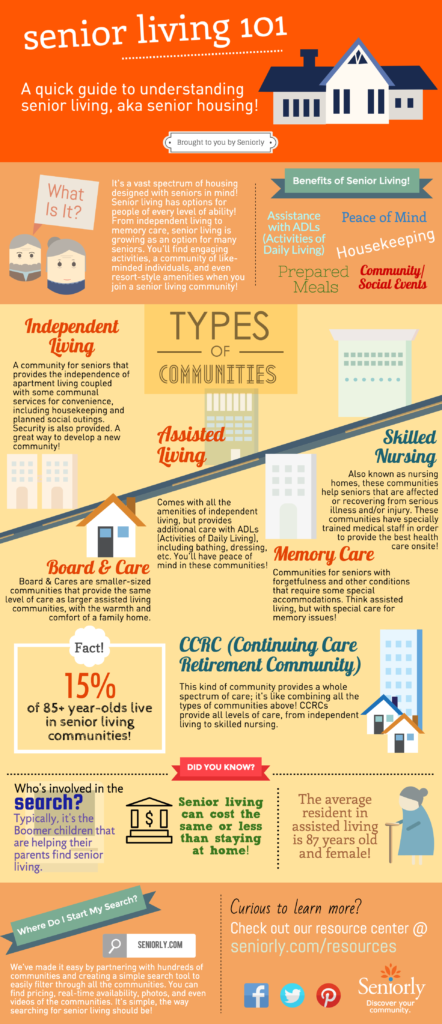Guest post by Jacqueline Hatch
Types of Senior Living Communities
Independent Living
Independent living communities were designed to provide independent seniors with the perks of apartment living coupled with some communal services for convenience, including housekeeping and planned social outings. Security is also provided. Independent living is a great way to develop a new community during those golden years!
Assisted Living
Assisted living comes with all of the amenities of independent living, while providing additional care with ADLs (Activities of Daily Living) including bathing, dressing, toileting, etc. Meals and snacks are also provided to residents throughout the day.
Memory Care
Memory care communities are meant for seniors with forgetfulness and other conditions (including Alzheimer’s and dementia) that require special care. Some memory care communities are designed to prevent wandering, a common side effect of dementia.
Skilled Nursing
Skilled nursing is a custodial medical care model which is usually covered by MediCal. Skilled nursing communities help seniors that are affected or recovering from serious illness and/or injury. These communities have specially trained medical personnel and social workers on staff in order to provide the best health care onsite.
Board & Care Home
Board & Care Homes are smaller-sized communities that provide the same level of care as larger assisted living communities, with the warmth and comfort of a family home. They typically have between 0-6 residents total, meaning that there is more opportunity for personalized care and one-on-one attention from community staff. These homes often provide assisted living, memory care, or a combination of the two.
CCRC
Continuing Care Retirement Communities provide a whole spectrum of care; it’s like combining all the types of senior living communities into one all-encompassing model. CCRCs provide all levels of care, from independent living to skilled nursing.
Alternative Senior Living Models
The Village Housing Model
The village model was created as a concept for alternative senior living. It’s a membership-based, multi-generational, grassroots community organization designed to help seniors age in place with access to supportive services such as home repair, transportation, and socialization opportunities. The village model is ideal for seniors with no care needs who would like to age independently, surrounded by a community of peers.
The Cohousing Movement
The cohousing model is another affordable option for seniors which combines the engagement of a senior living community with the privacy of one’s own home. Similar to the village model, cohousing offers seniors with a neighborhood-like atmosphere for independent living. Cohousing is residential collaborative housing, consisting of single-family homes augmented by common areas such as recreation spaces and dining rooms. Cohousing communities are a great option for middle-income seniors with no care needs.
Seniorly.com is a marketplace for senior living options that provides free resources for seniors and their families. With hundreds of housing options and comprehensive information including photos and reviews, families can take control of the retirement planning process and find the care that’s right for their needs.
Here’s a visual representation of the different types of long term care communities discussed above:

~
Jacqueline Hatch is the Content Manager at Seniorly, a company that provides free resources for families in need of senior care services. Her goal is to produce educational articles for Seniorly’s Resource Center to help families navigate the complicated world of aging options.
